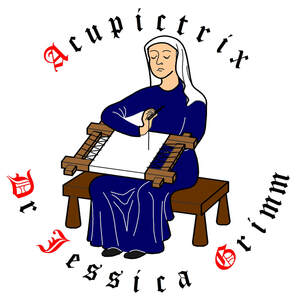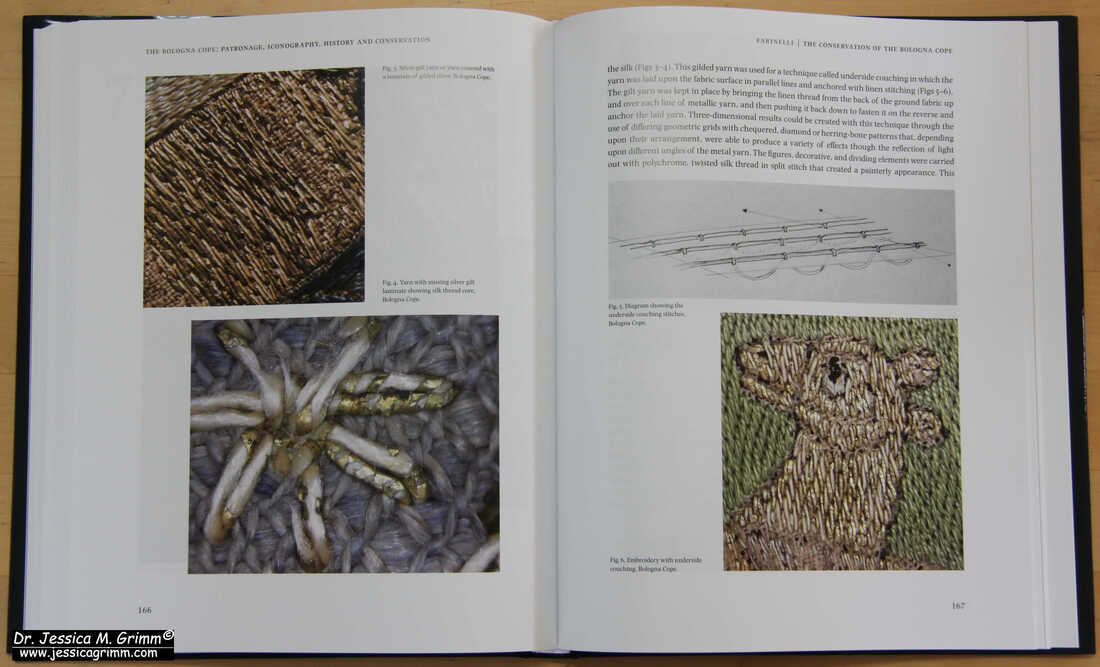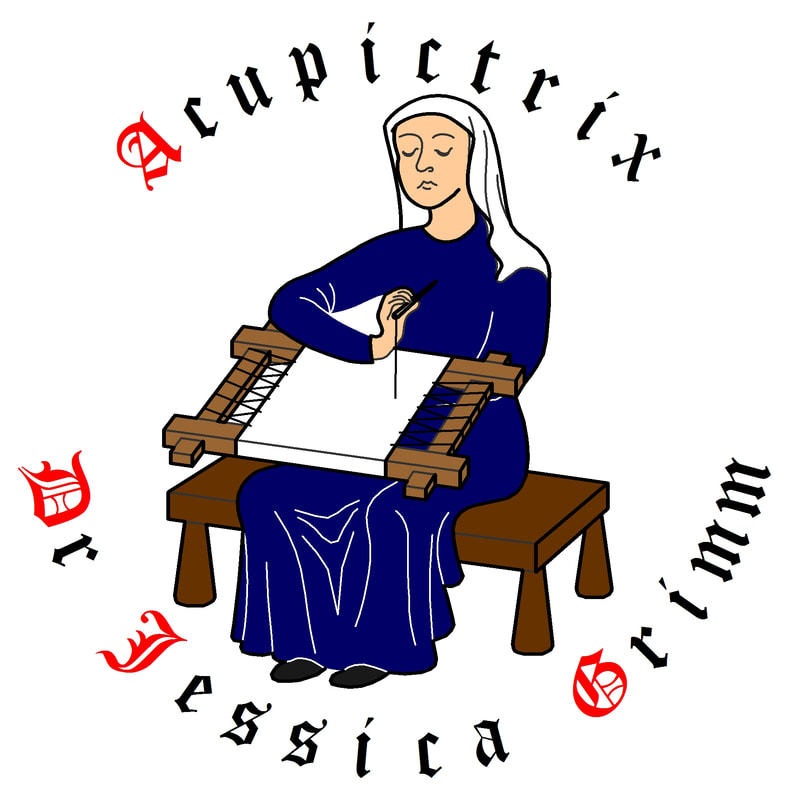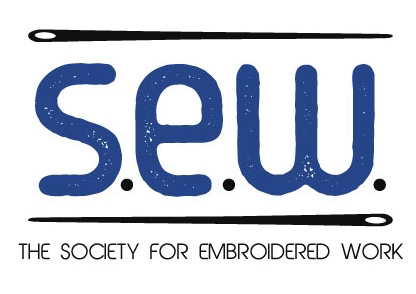|
Today I am going to introduce a new book on Opus anglicanum to you. One of my students posted about it in the Medieval Embroidery Study Group. As the book is written in English, the language used by most people in the international embroidery scene, these books are too important to ignore. They have the potential to become gospel. At € 125 + shipping, the book isn't exactly a bargain. So, let's explore its contents together so that you can make an informed decision as to whether to buy it or not. The Bologna Cope: Patronage, iconography, history and conservation is edited by M.A. Michael and is the second volume in the series "Studies in English Medieval Embroidery". The book can be ordered through Brepols publishers. As the Bologna cope is held in an Italian museum, the book's chapters are mainly written by Italian scholars. But as the editor is from the UK, the book is published in English. Italy has many splendid medieval embroideries and a large body of literature about them. However, it is all published in Italian. Not a language most of us are fluent enough in. The book starts with a general introduction to the subject. Those of you who went to see the Opus anglicanum exhibition in the Victoria & Albert Museum a couple of years ago, probably remember the Bologna cope as it was displayed right at the entrance. This first chapter also briefly introduces us to a few other embroidered vestments held in Italy. Neither the iconography on these pieces nor their embroidery techniques are described. The pictures are mostly not detailed enough to fill in the blanks. The second chapter is by M.A. Michael himself and mainly deals with stylistic comparisons between the design of the cope and several other works of contemporary art. It does have a rather good overview of the historical sources containing references to the makers and dealers in Opus anglicanum. However, a lot remains unclear as the dealers can often not be confidently separated from the makers. If you want to know more about the makers of Opus anglicanum, this chapter is not going to add much. A large chapter is devoted to the iconography of the cope. It is illustrated with many pictures of the embroidery. However, as many of the scenes are quite large, the pictures are mostly not detailed enough to learn more about the embroidery. Only a hand full provide enough detail. The next two chapters will not be of interest to most embroiderers. One chapter deals with the possible references made to this cope in the inventories of the Friars Preachers in Bologna. And the other chapter deals with the publication and exhibition history of the cope. The 6th chapter sounds very promising: "Textiles and Embroidery in Italy between 1200 and 1300". Unfortunately, the majority is on the fabrics and not on the embroidery. And don't be fooled. We are not getting an overview of embroidered pieces made in Italy in the 13th-century. It only briefly explores the remaining textiles associated with Pope Benedict XI (donor of the Bologna cope) and his predecessor Boniface VIII. Are there no other 13th-century Italian embroideries? There are! They can be found in the Victoria & Albert Museum, in the Domschatz in Aachen, in the Keir Collection and in the Museo Episcopal Vic. As I don't read Italian very well, my research into Italian medieval embroidery is slow and far from complete. This chapter should have been an excellent opportunity to thoroughly introduce a non-Italian reading audience to the topic. But it is the last chapter that really has me fuming: "The conservation of the Bologna cope". This chapter should contain a section on the materials and techniques used to create the embroidery on the cope. It doesn't. We are only told that the embroidery is executed on two layers of linen. Count, please! The gold threads are made of silver gilt foil wrapped around a silken core. Composition of the metals? Spun directions? Colour of silken core? Thickness? Any details of the silken threads used for the split stitch embroidery? Length of stitches? The chapter does contain a few close-ups and a few macro images (no scale!). But that is all. What a missed opportunity.
All in all, this book is, at best, a coffee table book. The research essays are not brilliant. For the embroiderer, this book is a huge disappointment and a missed opportunity. No information is added compared to the catalogue entry in "English Medieval Embroidery" from 2016. Should you buy the book? Only if Opus anglicanum is really your thing and you have the cash to spare. Instead, save up for the publications of the Abegg Stiftung and perhaps take some German lessons? Literature Browne, C., Davies, G., Michael, M.A. (Eds.), 2016. English Medieval Embroidery: Opus Anglicanum. Yale University Press, New Haven. Michael, M.A. (Ed.), 2022. The Bologna Cope: Patronage, iconography, history and conservation. Studies in English medieval embroidery II. Harvey Miller, London.
6 Comments
Agne
20/9/2022 10:56:11
Thank you for this review. I am waiting for this book myself and it is really pity, that this series is not going to be something really worth investing in.
Reply
20/9/2022 12:52:23
Oh, I did not know about that book! Just ordered it :). And well done you for learning German!
Reply
Andrejka
20/9/2022 16:28:46
I have the book of Anagni donations and I love it. Elster did a wonderful job describing the technical specifications of embroideries, iconographical comparisons as well as historical background. Many closeup photos.
Reply
Helen
8/3/2024 19:25:41
Thank you so much for this review. I've just started looking at O.A. in any depth & was wondering about this book.
Reply
Your comment will be posted after it is approved.
Leave a Reply. |
Want to keep up with my embroidery adventures? Sign up for my weekly Newsletter to get notified of new blogs, courses and workshops!
Liked my blog? Please consider making a donation or becoming a Patron so that I can keep up the good work and my blog ad-free!
Categories
All
Archives
July 2024
|
Contact: info(at)jessicagrimm.com
Copyright Dr Jessica M. Grimm - Mandlweg 3, 82488 Ettal, Deutschland - +49(0)8822 2782219 (Monday, Tuesday, Friday & Saturday 9.00-17.00 CET)
Impressum - Legal Notice - Datenschutzerklärung - Privacy Policy - Webshop ABG - Widerrufsrecht - Disclaimer
Copyright Dr Jessica M. Grimm - Mandlweg 3, 82488 Ettal, Deutschland - +49(0)8822 2782219 (Monday, Tuesday, Friday & Saturday 9.00-17.00 CET)
Impressum - Legal Notice - Datenschutzerklärung - Privacy Policy - Webshop ABG - Widerrufsrecht - Disclaimer








 RSS Feed
RSS Feed